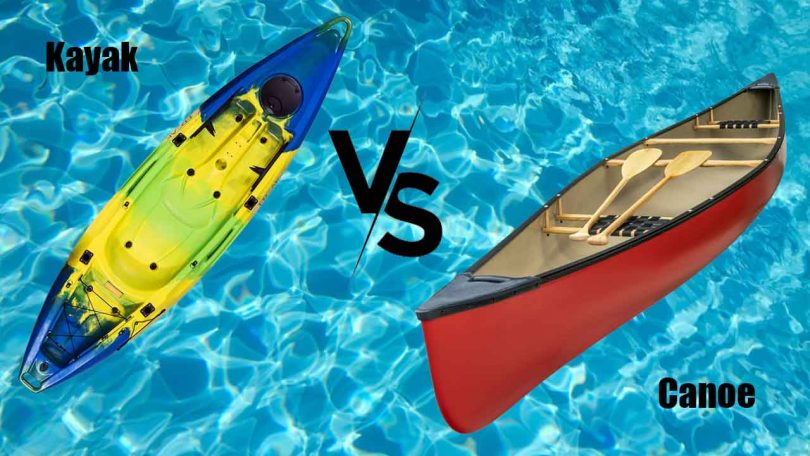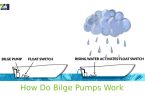When someone without any experience wants to pursue a popular water sport like canoeing or kayaking, the first thing they face is a confusion between a kayak and a canoe. If you have always wondered whether these two vessels are same or different, stay with us and learn more from our in-depth comparison.
Even though today’s kayakers and canoe riders follow the same disciplines except for the hobby users who do not bother much about learning the techniques and details. By the end of this article, the difference between canoe and kayak will be in your knowledge with practical insights.
To be honest, most people who developed some interests or tried them on a few occasions may not have proper ideas about these sports. Perhaps, some of you have heard that the Indians used to ride canoes.
However, the ultimate questions remain in the minds of enthusiasts, “What kind of boats are they? How are they constructed and used? What’s the difference between a kayak and a canoe and which one of them is better?”
Stay with us and enjoy the experts’ explanations on kayaking vs canoeing, backgrounds of these two types of boats, types, variations, design differences, material differences, as well as different uses. Let’s begin!
Table of Contents
Canoes vs Kayak: Definition
Alongside the underlying differences, we’ll also point out the pros and cons of each type, as well as some safety tips and tricks.
What Is a Canoe?
Originally came from Native America, the canoe is a small narrow vessel. The length of a canoe is somewhere between 13 to 18 feet. Primarily, they were made from yellow or red cedar. Most age old red canoes were made from this red cedar as this is well known for durability and lightweight performance. In modern days, different kinds of materials like polycarbonate, inflatable materials, fiber or even plastic is used to make a canoe. Canoe comes with open hull design and able to carry more than one person and offer a lot of storage space. Traditionally, they were propelled using a single-handed paddle; however, the motorized canoe is also found.

What Is a Kayak?
Kayak is also a small boat which is being used for thousands of years. Aleut, Yup’ik and Inuit people used them for hunting expeditions. Kayak is designed with cover deck with only one sitting arrangement which means kayak can carry a single person. However, there are a few tandem kayaks also available which can carry two persons. The benefit of the covered deck is that it prevents water to get in, which means it is sturdier than a canoe. Kayak is generally paddled with a dual handed paddle.

Canoes vs Kayak: Types/Variations
There are several different variations/styles of each vessel. They are suitable for different levels of expertise, different types of waters, i.e. calm and fast water, lakes, rivers, or seas, as well as different groups of people and paddling capacity.
Types of Kayaks
Let’s begin with kayaks. Today, we know two main types of kayaks. Those are:
- Sit-in kayaks
- Sit-on-top kayaks.
a) Sit-In Kayaks
Sit-in kayaks are divided into the following subtypes:
- Recreational (sea-river kayaks),
- Sports (multifunctional kayaks),
- Touring kayaks (designed for the sea, lakes and calm rivers),
- Small whitewater kayaks for adventurous sports
- Professional kayaks
- Inflatable kayaks.
The main advantage of these kayaks is the low-profile seating arrangements, and thus, the correct position of the spin in the rowing.
b) Sit-On-Top Kayaks
These are the types of kayaks on which you sit. You position yourself on top of it, on the predetermined positions. Sitting on a kayak allows you not to sink in the water. The greatest advantage of this type of kayak is the fact that all the water that enters the kayak goes out through the drain holes.
You may feel extremely mobile and flexible when you use a sit-on-top kayak. You can sit in the middle, jump, swim, dive, and get back when required. Sit-On-Tops are stable giving you great entertainment, whether you want to enjoy the sea, a river or a lake.
Types of Canoes
Let’s continue with types of canoes. Today, we know of several types of canoes. They include:
- Canadian canoes
- Whitewater canoes
- Racing canoes
a) Canadian Canoes
These canoes are perfect for family recreation. They are suitable for kids as well. These are also called recreational canoes. If you are looking for a canoe or kayak for beginners, Canadian canoes are worth considering offering you the required ease of use and control.
b) Whitewater Canoes
These canoes feature more advanced characteristics than Canadian canoes. They are suitable for faster water. The key difference in design is visible on all sides. Their higher design profile prevent water from entering the canoe. Also, you will have to kneel and paddle!
c) Racing Canoes
This type is designed especially for racing. Canoe racing is an Olympic sport for a century! Slalom and flatwater racing are two disciplines that require special skills and techniques, as well as some of the best canoes.
Difference in Design
If you have difficulties making a decision regarding a kayak or canoe, you may want to read the rest of this article. We’ll talk about the pros and cons of both types and help you decide wisely.
Simply put, the first differential aspect that an amateur should notice about the design is the use of different paddling tools for both vessels. A kayak requires two paddles, and a canoe uses only one. As a matter of fact, both kayakers and canoers use a single paddle, but kayakers have a paddle that has a ‘shovel’ on both ends while the canoers use a single-shovel paddle. This, of course, requires a different technique of paddling.
Another important design difference refers to the seating positions, i.e. sitting inside of a kayak, while the canoers kneel on one leg! These differences dictate a different design, which, in return, requires different techniques and strategies.
Technical Specification Design Differences
A canoe is designed to be heavier and bigger than a kayak. Its design is marked with an open top and a wide frame. Therefore, it is suitable for more passengers. On the other hand, a kayak is smaller in size, it can accommodate fewer people, and it is usually lightweight.
Here are some consequences that are the direct outcomes of the canoe, i.e. kayak design. You can easily climb and leave a canoe, but a kayak, depending on its type and design, might need some maneuvering! Also, you must count on getting wet in a kayak, which does not have to be the case with a canoe.
Finally, experts say that canoes are more stable than kayaks. However, this implies that a kayak is faster and more adventurous. Therefore, you should decide based on your own preferences and wishes.
Difference in Basic Features
In this section, we want to introduce you to very important basic features that’ll help us compare such as speed, stability, rigidity, maneuverability, etc. There are also a list of pros and cons that you should be going through before making your decision.
First of all, let’s clarify the speed issue. A kayak is faster than a canoe. Also, a kayak is easier to maneuver. You can easily handle it, even when there are serious waves. As we have already said that a kayak is a more adventurous boat than a canoe, the manufacturers have paid attention to safety and, today, kayaks are considered safe and advanced boats.
When it comes to relaxation, rigidity, higher walls, more room, and wider beams, canoes are the winners. On the other hand, canoes are more stable than kayaks. A kayak is easier to flip. Last but not least, canoes provide more freedom and easier movements.
To sum it up, we can say the following:
- A canoe is more stable, rigid, offers more space, and freedom.
- A kayak is faster, easier to maneuver, and more adventurous.
Materials explained
There are several materials used for kayaks and canoes. Due to the design differences, kayaks are made from several specific materials, while the canoes are made from other several materials usual for this type of boats.
Kayak Materials
Kayaks are usually made from:
- Polyethylene
- Rubber
- PVC
First of all, the sit-on-top kayaks are usually made from polyethylene. These are the most common kayaks on the seas and rivers today. With the constant progress in material technology and a wide range of kayaks, polyethylene holds the first place among the kayak materials worldwide.
Next, the inflatable kayaks. They’re usually made from rubber and PVC. This is a whole category for itself, incredibly different in design, purpose, and quality. Good rubber will make your inflatable kayak long-lasting and durable.
Are looking for a heavy-duty kayak? Pay attention to the construction material. It should have a hard PVC as an outer armor and inner tubes which are inflated through serious permanent valves which again have gliders and rafts made from solid materials.
Canoe Materials
Canoes are usually made from:
- Traditional wood
- PVC
Before the appearance of the sit-on-top kayaks, lakes and calm rivers were dominated by canoes. The problem was caused by fast rivers and the sea. Namely, when water comes in the small paddle and one or two people are not always ready to cope with it. Therefore, a canoe is definitely a family boat for lakes and calm rivers. Why are we pointing this out? The choice of materials depends on the use as well.
The most popular models today are made from durable plastic to ultra-light and traditional wood. A quality, the modern canoe will delight you with its performance. Its materials should ensure the following features: being lightweight and robust, with excellent craftiness and manageability.
Difference in Uses
Here, we come to one of the most important points of our kayak vs canoe discussion. The points include the uses and other differences.
The advantages of a canoe include its family-friendly nature. What does this imply? A canoe is designed for more people. Fun with your family or friends is guaranteed. Its generous room design postulates allow enough space for legs, even pets! These boats are great for calm water.
When it comes to the competitive difference of a kayak, we want to point out that these boats are better for solo users. If you want to enjoy water and nature alone, pick a kayak. Moreover, they are better for fast water. If you are adventurous, you will benefit from buying a kayak.
Need for accessories
Different accessories are required for canoeing and kayaking. Here are some of the kayak accessories:
- Vests
- Dry bags – to keep your things dry
- Protection for your electronic devices, keys, money
- Lycra T-shirts – UV protection
- Neoprene suits – thermal protection
- Shell blanket – for Sit-in kayaks
- Kayak Seats – for Sit-in kayaks.
Here are some of the accessories you should buy for canoeing:
- Paddles
- Repair kits
- Anchor bags
- Bow bags
- Spray skirts.
Which One Offers More Stability?
- The canoe is usually designed in a way that, it stays a bit higher on the water, which makes it a bit less stable, especially when you are going to catch fish in a standing mode. Of course, you can catch fish with a canoe in the rough Mastering the skills of canoe fishing with is a matter of practice and time.
- Moreover, you can choose outrigger canoe if you often fish in rough water. Outrigger canoe offers at least one lateral support to provide more stability in rough
- Kayak is designed to keep you closer to water and hence makes more stable moves. There are also sit-on-top kayaks which offer flexibility to fish while standing.

Dependability on Rough Water
- In rough water, both kayak and canoe struggle a lot as they are a relatively small vessel.
- For a recreational canoe, they tend to suffer more as they sit high on the water. So, fishing while standing on any of these canoes is not much safe. However, for calm water canoe is the best fishing boat.
- Kayak can handle rough water more than a canoe. The covered in-water design allows them to handle shakes more than most boats. However, sit-on-top kayak still suffers a lot in rough weather.
Storage Space for Fish and Fishing Gears
- Not only for keeping fishing gears, but you also need a room for safekeeping your fish. With its open deck design canoe lets, you put all of your fishing gear, fish carrying case and much more. However, they are unable to protect your stared goods from bad weather or water that may accidentally splash
- For a kayak, storage space may vary according to its type. Hybrid kayaks offer moderate space for fishing, but sit-on-top kayak has no space to offer except the sitting space.
Comfort for Long Time Fishing
- With an open hull, design canoe provides extra room for stretching your leg and body as much as you want. This feature particularly gives you more comfort than a kayak when you are in a long time fishing mood. Canoe also stays higher on the water than kayak which means you are less likely to get drenched by splashed water.
- Ordinary kayak does not provide enough space for body movement. Sit-on-top kayak offers limited space for body movement but, the seat is situated in the hull which might feel uncomfortable if someone stays for a longer time.

Which Is Pricier Fishing Boat?
Price is an important factor when choosing between a kayak and a canoe. The Price varies on a lot of factors. Generally, canoe is a bit pricier than a kayak. Then again, it depends on design and material.
Inflatable kayaks are less expensive than other type kayaks. However, if you are looking for a recreational kayak or a hybrid kayak, you need to pay more.
Summary
In summary, both canoe and kayak are good for occasional fishing. However, for a happy fishing experience, you’ll need to consider the above factors and choose according to your need. If budget is a big issue, consider buying a good quality inflatable kayak.
On the other hand, if you want more comfort for a longer time, a good quality canoe can provide full body movement with plenty room to spare. See the chart given below to see the comparison of overall fishing performance between a canoe and a kayak.

Final Words
Fishing is an exciting way to pass some leisure time. To some,, fishing is a habit, and to others, it’s something more. Fishing soothes our heart and removes mental stress. For quality anglers, fishing boat is a must as land fishing is less enjoyable and finding fish in single spot is becoming scarcer. Fishing with a fishing boat offers great boating experience with quality fishing time. Both kayak and canoe are highly popular for fishing in river, lake or even offshore fishing. However, choosing the right one is tough.
Hopefully, our article will provide enough insight about kayaks and canoes so you can choose your dream fishing boat according to your need. For any more queries, please write us. Happy Fishing!








Leave a Comment